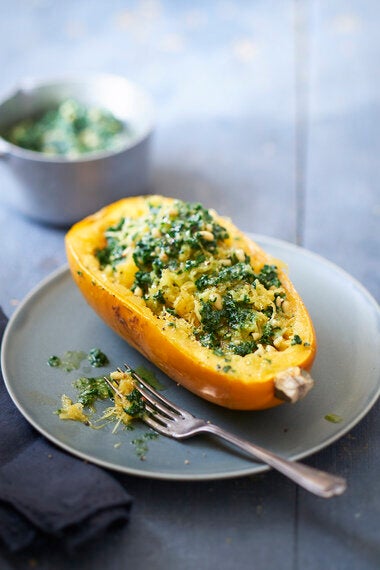This is a wonderful substitute for spaghetti for those on a gluten and grain free diet.

{serves 4 as main course or 8 for starters}
ingredients
4 spaghetti squash
4 tbsp. olive oil
sea salt
pesto
160g cavolo nero (black kale) cut away the stalk
85g pine nuts
85g parmesan cheese, grated
10 tbsp. olive oil (9 tbsp. olive oil when blending a save 1 tbsp. olive oil at the end)
2 garlic cloves, pureed
2 pinches sea salt
black pepper
Preparation time - 30 mins, cooking time - 60 mins
Pre-heat the oven to 400°F, gas mark 6, 200°C (180°C fan-assisted).
Cut the spaghetti squash in half and scoop out the seeds. Drizzle ½ tbsp. olive oil over each squash and season with salt.
Place the squash on a My Relationship with Food silicon baking mat or parchment paper, flesh side down and drizzle the rest of the olive oil over the spaghetti squash.
Bake in the oven for 50-60 minutes, check after 30 minutes (if it's a big squash then you'll need to bake for 60 minutes).
Whilst the squash is baking in the oven you can make the cavolo nero pesto. Cut the leaves away either side of the stem, and discard the stalk. Rinse the leaves under cold running water. Place the leaves in a steamer, I use a bamboo basket, lined with parchment paper placed over a saucepan of boiling water. Bring the water to the boil and steam the cavolo nero for 10 minutes. Remove from the heat, leave to cool. Place the cooled wilted leaves in the palm of your hand and squeeze out the excess moisture in to a bowl. Alternatively you can place in a clean tea towel and squeeze through, (discard the water).
In a food processor add the cavolo nero, parmesan, pine nuts, 9 tbsp. olive oil and garlic puree and blend, you will need to stop start occasionally and wipe down the sides. Season with sea salt and black pepper. The consistency should be quite coarse, although ensure the mixture is thoroughly combined (you can add extra oil if you prefer it loose).Decant into a kilner jar and top with 1 tbsp. olive oil. Eat straight away! Or you can keep stored in the fridge for 1 week.
When the spaghetti squash is cooked, turn over and using a fork pull it through the flesh of the squash, it will create spaghetti strings. If I am serving a whole spaghetti squash as main course, scoop out one half of the squash and place into the remaining half if presenting in the shell. Add 1-2 tbsp. of cavolo nero pesto to the squash and mix it in with the spaghetti squash.
If you are serving this as a side dish or starter for 8 people, scrape out all the spaghetti squash into a large mixing bowl or platter and add 8 tbsp. cavolo nero pesto and serve with a delicious salad on the side!
LISA'S TIP
Winter squashes are an excellent source of vitamin A as well as Vitamin C, potassium, dietary fibre and manganese. Spaghetti squash looks like other winter squash varieties and when raw the flesh is the same, but when cooked the flesh falls away in ribbons, like spaghetti.
For more recipes from Lisa Roukin visit http://www.myrelationshipwithfood.com